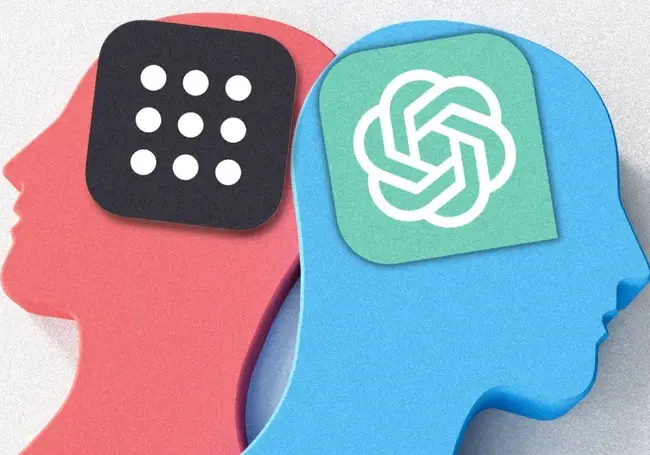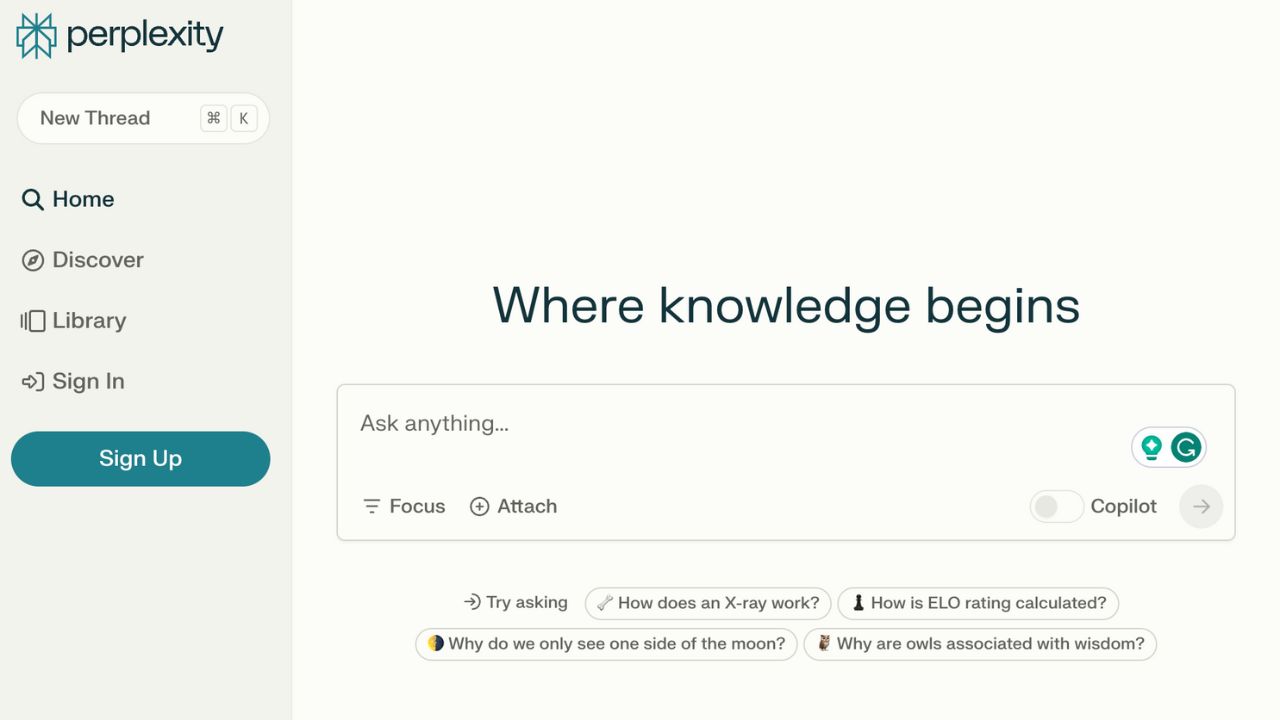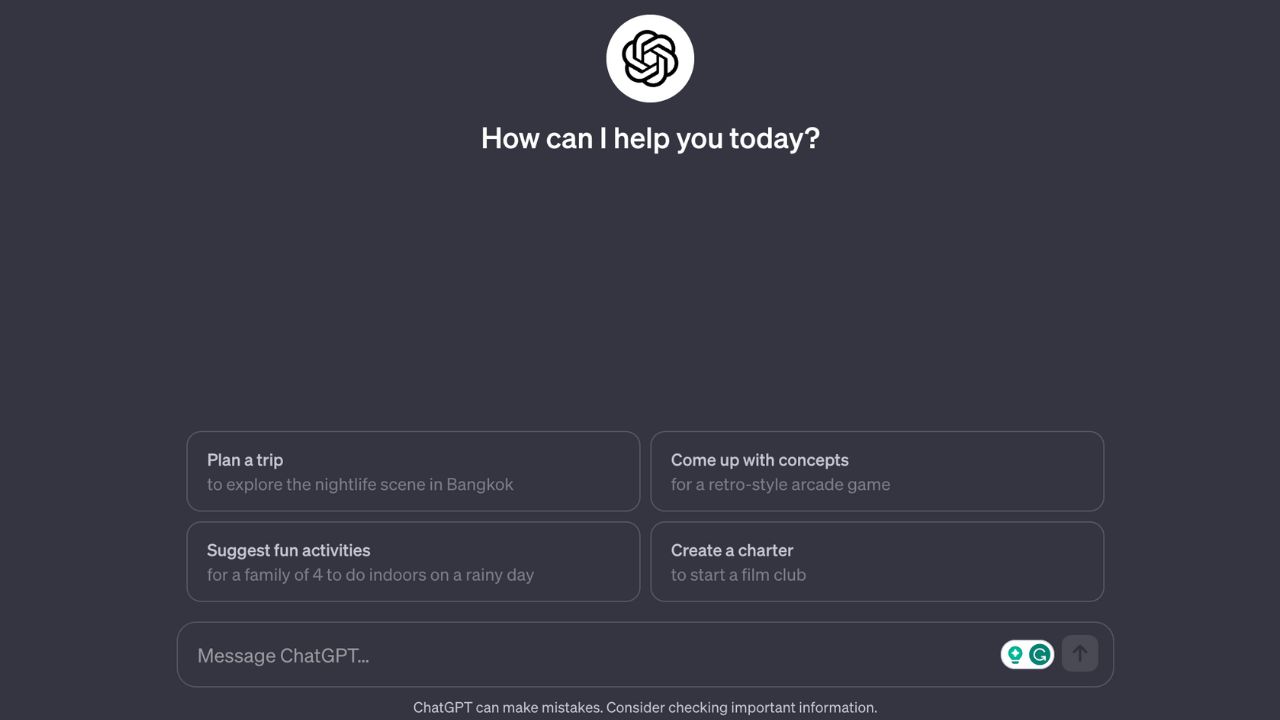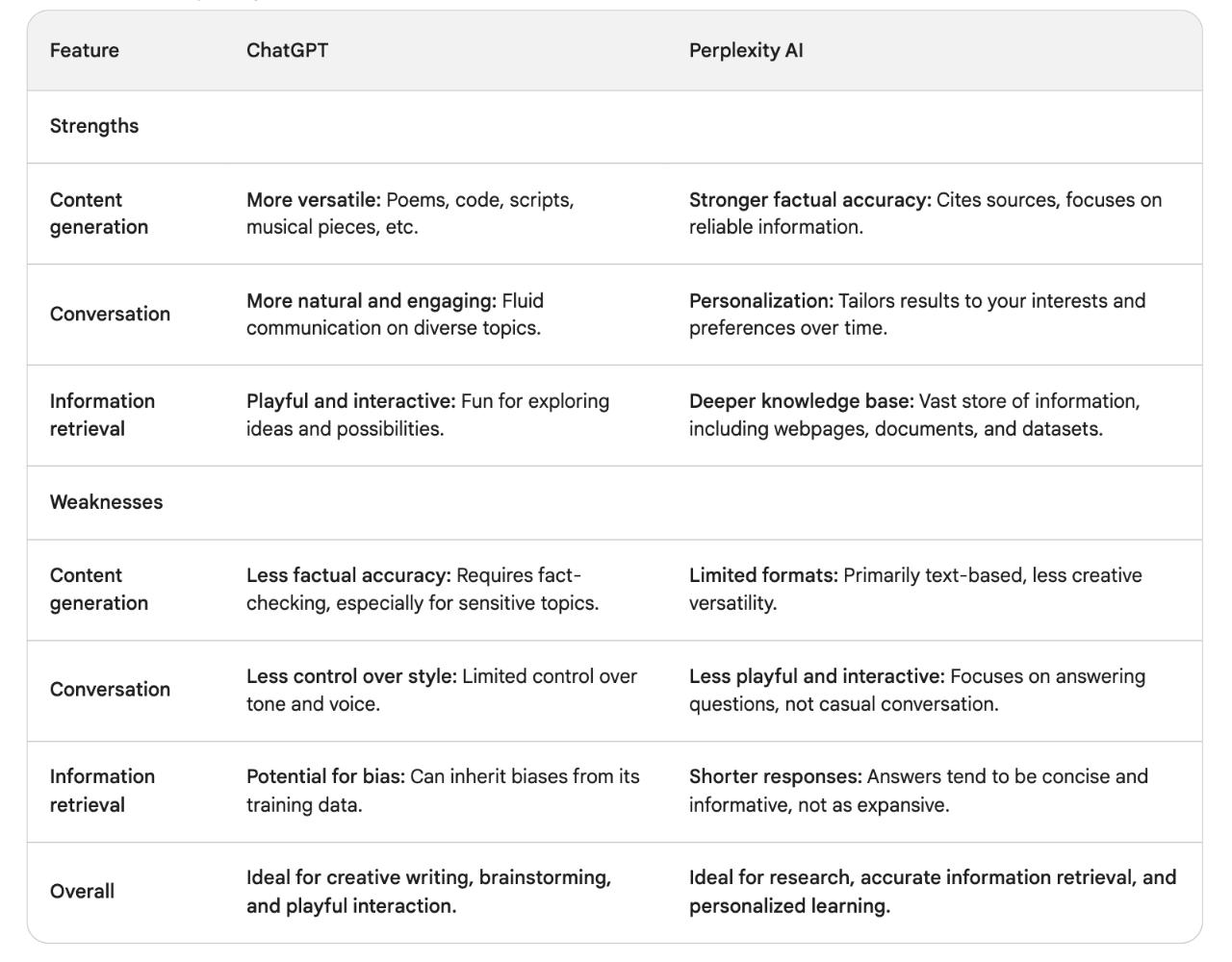
The way we search for information on the internet is changing.
Thanks to recent advancements in deep learning and the rise of generative AI, people have more ways than ever before to access the information, products or services they're looking for.
At the forefront of this shift is the growing collection of AI search tools and chatbots available today, which have captured the attention of people all over the world for their powerful functionalities and ability to answer questions on almost any topic.
Two of the most popular AI tools available today are Perplexity AI and ChatGPT, which have both garnered recognition from internet users around the world for their incredible AI search functionalities and ability to find and gather information faster than search engines.
But, while these two tools are both designed to provide users with up-to-date information and answers to their questions, their approaches and capabilities for doing so are noticeably different.
This article explores some of the key differences between Perplexity AI vs ChatGPT, comparing the chatbots' respective features, advantages and limitations to find out which one is better in 2024.
What is Perplexity AI?
Perplexity AI is an innovative AI search engine and knowledge discovery platform that goes beyond text pages and keyword matches by providing direct responses to user queries.
Launched in 2022, It leverages AI to understand the real meaning of your questions, analyze vast amounts of information, and deliver accurate, up-to-date, and contextually relevant answers.

Perplexity AI homepage. Source: Perplexity.ai
Unlike traditional search engines that rely on keywords, Perplexity AI focuses on understanding your intent. It analyzes your query, the context of your previous interactions, and your overall knowledge base to determine what you're truly seeking.
Perplexity AI isn't limited to text either. While it may work best for text prompts, it can also understand and generate various media formats like images, videos, and audio into its responses.
Perplexity AI is available in two versions:
- Perplexity Free – includes all of the standard features of Perplexity including the AI search functionality, multi-media support and more.
- Perplexity Pro – raises Perplexity to the next level with more Copilot, an upgraded AI, unlimited file upload, and API access. This costs $20 per month or $200 per year.
Key Features of Perplexity AI
Perplexity AI has a range of functionalities that allow it to provide relevant and accurate responses to your queries. Some of these key features include:
1. Contextual Understanding
Unlike keyword-based search engines, Perplexity AI uses advanced natural language processing (NLP) to grasp the deeper meaning and context behind your queries. This allows it to provide more relevant and insightful results, even for complex or open-ended questions. Imagine having a knowledgeable friend who truly understands what you're looking for, not just the keywords you typed.
2. Real-time Web Search
Perplexity AI continuously crawls the web, indexing and analyzing information in real time. This means you get access to the latest updates and breaking news as soon as they happen, no more waiting for search engine algorithms to catch up. Think of it as having a live feed of the most relevant and up-to-date information on any topic you can imagine.
3. Diverse Source Integration
Perplexity AI goes beyond just websites and traditional search results. It taps into a vast array of sources, including academic journals, industry reports, and even social media discussions, to provide you with a well-rounded perspective on any topic. It's like having a research assistant who can scour the entire internet and present you with a curated selection of the most valuable information.
4. Human-like Explanations
Perplexity AI doesn't just give you answers; it explains them clearly and concisely, using natural language that you can easily understand. This makes it ideal for anyone who wants to learn more about a topic, not just find a quick answer. Think of it as having a patient and knowledgeable teacher who can break down complex concepts into bite-sized pieces.
5. Advanced Summarization
Perplexity AI can condense lengthy articles and reports into concise summaries, saving you valuable time and effort. This is particularly helpful for quickly grasping the main points of complex topics or staying up-to-date on the latest news. Imagine having a personal cliff notes generator that can give you the gist of anything you need to know without having to read the entire thing.
6. Citation and Source Verification
Perplexity AI understands the importance of reliable information. It provides citations for all its results, allowing you to verify the source and credibility of the information you're consuming. This is essential for anyone who needs to do research or make informed decisions based on accurate data.
What is ChatGPT?
ChatGPT is a large language model (LLM) trained on a massive dataset of text and code from the internet, allowing it to engage in conversations and answer questions on any topic from the user.
Developed by the AI research company OpenAI, the chatbot can generate human-quality text, translate languages, write different kinds of creative content, and most importantly, hold engaging conversations on various topics.

ChatGPT homepage. Source: OpenAI
ChatGPT was one of the first chatbots of its kind when it launched in November 2022. It's largely credited with setting off the AI revolution that has gripped Silicon Valley over the past year or so, and has since reached over 180 million users and is backed by tech giants such as Microsoft and Inosys, making OpenAI a frontrunner in the AI race.
But that doesn't mean ChatGPT is the best chatbot in the world, it just means it's the oldest - and that isn't always a good a thing. Many of the other chatbot providers have since borrowed OpenAI's GPT LLM to use in their own, specialised chatbots, meaning that there are many chatbots out there with similar capabilities to ChatGPT.
Like perplexity AI, ChatGPT comes in two versions:
- Free GPT-3.5 version. This is the most widely available version, accessible through the ChatGPT website and open to anyone. It uses the GPT-3.5 language model and offers basic conversational capabilities, creative text generation, and information retrieval.
- Paid GPT-4o version (ChatGPT Plus). This premium version offers advanced features and capabilities compared to the free one. It uses the more powerful GPT-4 language model, making it more accurate and more up-to-date. This version is also multimodal, meaning it can understand and respond using text, images, and even audio.
Key Features of ChatGPT
ChatGPT has a range of generating content and communicating with the user. Some of its key features include:
1. Strong Conversational Abilities
Thanks to its powerful natural language processing (NLP) capabilities, ChatGPT shines in carrying on natural-sounding conversations. It can respond to your queries in a way that mimics human interaction, adapting its tone and style to fit the context. Think of it as a chatty and knowledgeable friend you can bounce ideas off of.
2. Text Generation
ChatGPT excels at generating different creative text formats, allowing you to create poems, scripts, musical pieces, emails, letters, and more. You can provide it with prompts or specific instructions, and it will craft unique and engaging text content.
3. Diverse Applications
ChatGPT's capabilities extend beyond simple conversations. It can translate languages, summarize information, write different kinds of creative content, and even answer your questions in an informative way, even if they're open-ended, challenging, or strange.
4. Adaptability and Personalization
One of ChatGPT's key features is its ability to learn and adapt. The more you interact with it, the better it understands your preferences and communication style. This level of customization leads to more meaningful and relevant interactions over time.
5. Constant Development
ChatGPT is constantly being updated and improved by one of the world's leading AI research teams. This means its capabilities are expanding all the time, offering users access to new features and functionalities.
6. API Access
Thanks to OpenAI's open-source API, you can integrate ChatGPT into your own applications and projects to leverage its capabilities. This makes it incredibly versatile and available for use by both developers and end users.
Perplexity AI vs ChatGPT: Which is Better?
Perplexity AI and ChatGPT both excel in different areas. Perplexity is better at providing accurate and up-to-date information, drawing upon reliable sources from the internet and citing them for verification.
But ChatGPT does a better job at responding to open-ended, complex questions and generating creative content or code for the user. GPT-4o is also multimodal, meaning it can understand and generate responses using text, images and even audio.
To understand which AI tool is better for you, you need to think about what you’re using them for. Let’s run through some of the pros and cons of using Perplexity vs ChatGPT:

Differences
1. Factual Accuracy
Perplexity draws its responses from a range of live webpages from the Internet, including academic databases, the Wolfram Alpha physics and mathematics knowledge base, YouTube, Reddit, and news outlets from around the world. This means it can provide users with the most updated and accurate response to a query as well as source citations, so they can verify the information and dive deeper into a particular subject
ChatGPT, on the other hand, relies on its massive dataset of text and code scraped from the internet several years ago, and is more likely to provide out-of-date or inaccurate information.
If you’re looking for factual information, Perplexity AI is therefore the better choice. It’s generally more up-to-date and accurate due to having access to more recent data than ChatGPT and addresses questions with links and sources for verification
2. Quality of Responses
Perplexity excels at finding accurate and insightful answers to complex questions. It provides users with a summary to answer their query along with citations so they verify the information and dive deeper into the question.
ChatGPT, on the other hand, generates human-like responses to user queries but doesn’t say where it got its information from. This makes it a great companion for casual conversation, exploring ideas, and brainstorming, but not as good as Perplexity at responding to topics in depth.
This makes ChatGPT more suitable for general uses like generating content and answering basic questions but means Perplexity is better for researching a topic in depth.
3. Natural conversation
When it comes to communicating with the user, ChatGPT has it in the bag. Trained on OpenAI’s GPT- 3.5 and GPT -4 for the pro version, it can answer your questions in a comprehensive and informative way, even if they're open-ended or challenging.
Perplexity, on the other hand, is primarily trained on factual information and structured data, making it adept at finding answers to well-defined questions with clear intent. Open-ended questions, however, often lack structure and ambiguity, which can confuse the model's understanding.
Perplexity excels at summarizing information and responding to factual queries. But generating responses to open-ended questions requires a higher level of understanding and imagination, which are areas where Perplexity is still under development. Its responses tend to feel less natural or engaging compared to ChatGPT.
4. Generating content
ChatGPT is much more versatile than Perplexity when it comes to generating content and generates various formats like poems, code, scripts, musical pieces, emails, letters, etc. It also allows you to specify the tone, style, and format of the output, giving you more control over the creative direction of the content it creates.
Perplexity Strives to provide accurate and up-to-date information rather than generating creative content. Its answers are typically well-structured and concise, making it better for answering questions than being used for content creation. Still, perplexity generates detailed and contextually relevant content, especially for research or summarizing information.
5. Cost
Both ChatGPT and Perplexity AI come in free and paid-for versions. Comparing the cost of these versions can be a bit tricky, as both platforms offer different pricing structures and features.
With Perplexity, the free tier gives you limited access to features, shorter answer length, and potential wait times – though I’ve never had to wait long for responses personally. The pro tier costs $20/month and unlocks all features, longer answers, priority access, and personalized recommendations. There’s also custom pricing for businesses and organizations, with additional features and support.
When it comes to ChatGPT, the free tier gives you access to the less powerful GPT -3.5, which means fewer features, shorter response lengths, and more outdated responses. ChatGPT Plus costs $49/month unlocks, but unlocks a huge amount of new features, including access to GPT-4o, priority access, and plugin compatibility.
So while the pro version of Perplexity might be cheaper, ChatGPT brings a host of powerful AI features that make it worth spending the extra cash.
Final Thoughts
Perplexity and ChatGPT are both extremely powerful AI tools with unique features to help answer queries and generate content. While Perplexity AI excels at providing search engine functionality and sourcing capabilities, ChatGPT is better suited for creating content and general use.
Ultimately, the best choice depends on your individual needs and priorities. It's important to experiment with both tools for yourself and see which one suits your needs best.
Regardless of which one you choose, be sure to always double-check your answers as both tools have the tendency to provide inaccurate information from time to time.












